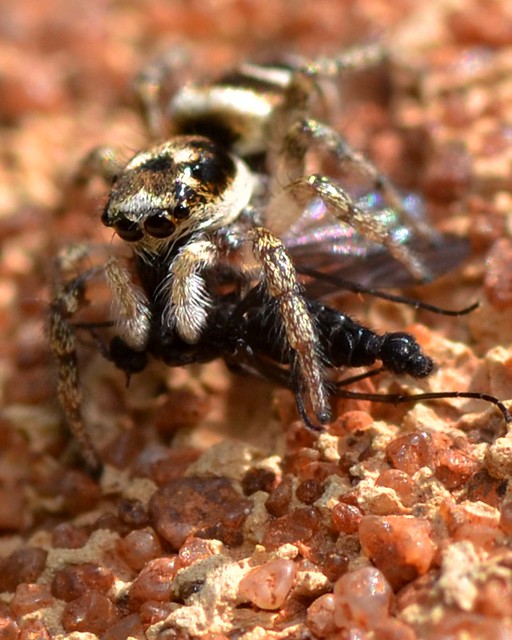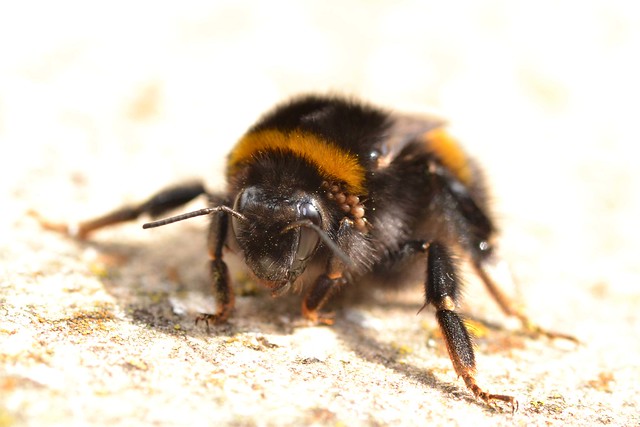Welcome to the fascinating world of the small Ian. I think you've made a good start.
Getting the centre of focus positioned for best effect takes practice. For full body shots with subjects in orientations like the first two I tend to aim for the back of the "neck", just behind the head. For straight-on shots like the third one I would probably aim between the eyes.
Views differ as to manual focus versus autofocus (and I think it depends on the camera you are using too). And opinions differ as to apertures. And flash. In each case I think you need to experiment and find what works for you. Be prepared for this to take some time as there are a number of variables interacting and it can be tricky to establish exactly what (combination of) factor(s) is causing particular (often undesirable) effects.
Most people use manual focus for closeups and macros I think, but a significant minority use autofocus. (FWIW I tend to use autofocus for invertebrates and manual focus for botanical subjects, but by no means always. And that isn't a recommendation. As with similar comments below, it is simply an indication of something that works for some people and not for others, and so something you might want to try for yourself.)
Most people don't use apertures as small as you used for these. One complication is that when using a macro lens the effective aperture (which is what determines the amount of diffraction loss) may be smaller than the nominal (as set on the camera) aperture. I say "may be" because I've got a vague memory that Nikon, alone amongst manufacturers I think, shows the effective aperture. But I don't know whether this would be the case for third party lenses like the Tamron. Anyway, the formula is
Effective aperture = Nominal aperture * ( 1 + magnification).
So, for example, if you are using f/22 at 1x magnification (1:1 magnification) then the effective aperture is f/( 22 * ( 1 + 1) ) = f/44.
Similarly, Nominal f/22 at 0.5 magnification (1:2) is f/( 22 * ( 1 + 0.5) ) = f/33 effective
Nominal f/22 at 2x magnification (2:1) is f/( 22 * ( 1 + 2 ) = f/66 effective
So if Bryn uses his Venus lens at f/11 with full (2x) magnification his effective aperture is f/33, and if he were to use his MPE-65 at f/11 with full (5x) magnification his effective aperture would be f/66.
FWIW I use the equivalent of around effective f/32 most of the time for invertebrates. (I say "equivalent" because I don't actually use macro lenses, but that's another story and not relevant for your setup.)
Magnification also effects the shutter speed you need to use to avoid loss of sharpness from hand-shake. You'll be aware of the 1/focal length guideline for handholding. (e.g. 1/400 sec for a lens with a focal length of 400mm in full frame terms.) As you know, what shutter speed you can actually use depends on how shaky your hands are, how you hold the camera etc. It is the same for macro/closeups, except the formula needs to be adjusted to
Suggested shutter speed = 1 / ( focal length in full frame terms * ( 1 + magnification) ^ 2)
Here is a table of suggested shutter speeds with the items of most relevance to you shown in yellow. Image stabilisation can in principle allow you to use slower shutter speeds than would otherwise be the case. However, as far as I can see your lens doesn't have image stabilisation, and in any case image stabilisation becomes less effective as magnification increases and so may not provide much help at all when you are operating around 1:1.

Shutter speeds - suggested for hand-held close-ups and macros - 90mm to 1to1 highlighted by
gardenersassistant, on Flickr
Flash helps considerably with shutter speed/hand-shake issues. As the magnification increases further beyond 1:1 flash becomes pretty much mandatory, especially for working hand-held, because the effective shutter speed when flash is the dominant light source is the length of the flash pulse, which is very short (unless you are using HSS/FP flash, which is unlikely if flash is the dominant light source). It may be best when using flash to force the shutter speed to the maximum sync speed so as to avoid getting softness or even "ghost" images on brighter days from the natural light component of the illumination.
For hand-held work you might want to consider raising the ISO beyond the ISO 400 you used for these shots if you can't otherwise get a suitably fast shutter speed with the aperture you want to use. To some extent this depends on your attitude to and skills with post processing in general, and noise control in particular. In fact, you might in due course find that developing your post processing skills may be an integral part of improving your results with closeups/macros.
You may later want to experiment with raising the ISO and/or using slower shutter speeds even when using flash. This can help to avoid black backgrounds which you tend to get when using flash and which some people find unattractive.
I see that all three images have been cropped. Without knowing whether you resized after the crop I can't tell how much of a crop these were, but obviously the more you crop the more detail you lose. Cropping is fine, including radical crops, perhaps even as far down as 100% sometimes, but you do need a good sharp image to work with if the subject is to remain sharp and detailed after a significant crop,
Hope some of this is helpful.
 Weevil by Ian NUFC, on Flickr
Weevil by Ian NUFC, on Flickr Fly by Ian NUFC, on Flickr
Fly by Ian NUFC, on Flickr Blue Bottle by Ian NUFC, on Flickr
Blue Bottle by Ian NUFC, on Flickr Weevil by Ian NUFC, on Flickr
Weevil by Ian NUFC, on Flickr Fly by Ian NUFC, on Flickr
Fly by Ian NUFC, on Flickr Blue Bottle by Ian NUFC, on Flickr
Blue Bottle by Ian NUFC, on Flickr


 Jumping Spiders Dinner
Jumping Spiders Dinner Jumping Spider Jaws
Jumping Spider Jaws Jumping Spider Jaws 2
Jumping Spider Jaws 2 Bee Mites
Bee Mites